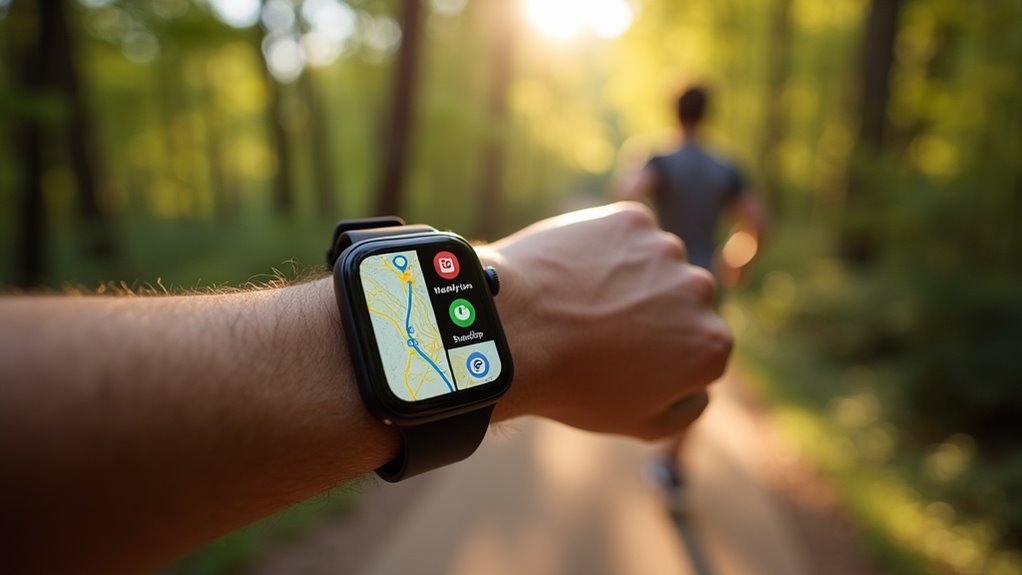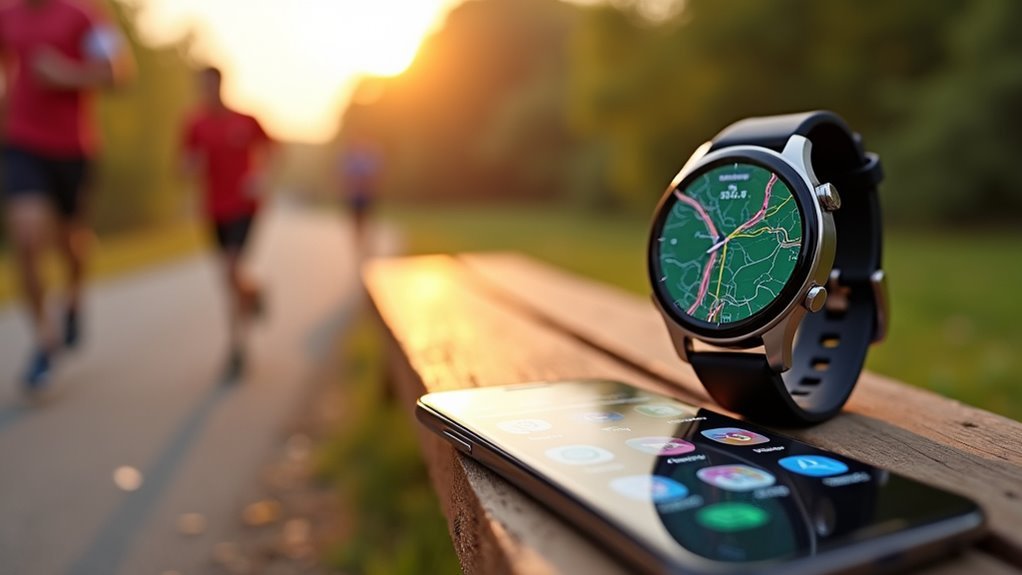You can replace Strava with several excellent wearable GPS alternatives that offer robust tracking capabilities. Garmin Connect provides extensive performance analytics including VO2 max and training load data. Komoot excels at route planning with offline navigation and turn-by-turn directions. AllTrails offers trail discovery with community reviews, while Adidas Runtastic tracks over 90 different activities. Apple Health integrates seamlessly with Apple Watch for GPS tracking. Explore these options to find the perfect fit for your fitness goals.
Popular Wearable GPS Alternatives to Strava

While Strava dominates the fitness tracking landscape, you’ll find several compelling alternatives that offer unique strengths for different workout styles and preferences.
Garmin Connect delivers thorough performance analytics including VO2 max and training load, making it ideal for serious athletes seeking detailed insights.
Serious athletes will appreciate Garmin Connect’s comprehensive performance data, including VO2 max calculations and detailed training load measurements.
Apple Health seamlessly integrates with Apple Watch, collecting GPS and heart rate data while providing health trend analysis.
For trail enthusiasts, AllTrails excels with extensive offline trail maps and user-generated route reviews, though it lacks advanced performance metrics.
RunKeeper offers solid GPS tracking with pace and distance analysis, compatible with Wear OS devices.
Zwift stands out for virtual training environments while supporting outdoor GPS activities, perfect for cyclists and runners wanting interactive experiences.
Nike Run Club provides a completely free alternative with coached sessions, run tracking, and local runner connections, making it an excellent value option for budget-conscious athletes.
Komoot for Advanced Route Planning and Offline Navigation
You’ll find Komoot excels when you need detailed route planning that works without cell service.
The app provides turn-by-turn voice navigation so you can focus on the trail instead of constantly checking your device.
Whether you’re cycling through remote gravel paths or hiking mountain trails, Komoot’s offline maps guarantee you’ll stay on course even in areas with zero connectivity.
The platform offers thousands of tailored adventures based on your explorer type and specific outdoor preferences.
Offline Maps and Navigation
When you’re exploring remote trails or venturing into areas with spotty cell coverage, Komoot’s offline mapping capabilities become essential for reliable navigation. You can download maps before your ride and rely on turn-by-turn directions without internet connectivity.
| Feature | Komoot | Strava |
|---|---|---|
| Offline Maps | Full region downloads | Limited offline access |
| Navigation | Complete turn-by-turn offline | Requires internet connection |
| Cost Model | One-time regional fees | Monthly subscription required |
| Route Planning | Free for one region | Premium subscription needed |
Komoot’s strength lies in its thorough offline functionality. You’ll get detailed surface analysis, elevation profiles, and route customization even when you’re completely disconnected. The app syncs seamlessly with GPS devices like Garmin and Wahoo, making it ideal for serious exploratory cycling adventures. The app’s community-driven approach creates a rich database of user-generated routes and local insights that enhance your navigation experience.
Voice-Guided Route Directions
Komoot’s voice-guided navigation transforms your cycling experience by delivering clear, turn-by-turn directions that keep you focused on the trail ahead rather than your screen.
You’ll receive audio prompts for every twist and turn, even on narrow mountain paths, reducing distractions and potential accidents during fast descents or technical terrain.
The voice guidance syncs seamlessly with your connected devices, including Garmin Edge computers and Wahoo bike units, transferring routes in seconds.
You can customize voice settings to match your preferences and riding style. Additionally, you’ll find notification customization options that allow you to tailor alerts and prompts to your specific needs during navigation.
While weather conditions or high speeds might occasionally affect audio clarity, this hands-free navigation proves invaluable when manual device interaction isn’t safe or practical, enhancing your overall outdoor adventure experience.
Hiking and Cycling Focus
Beyond clear audio cues, Komoot stands out as a thorough planning powerhouse that transforms how you approach cycling and hiking adventures. You’ll discover superior surface analysis that identifies rideable trails while avoiding problematic terrain for gravel, off-road, and mountain biking activities.
| Feature | Komoot Advantage |
|---|---|
| Route Planning | Free in one region vs Strava’s subscription requirement |
| Surface Analysis | Advanced terrain identification for mixed surfaces |
| Offline Maps | Download regions for navigation without cell service |
| Community Insights | Highlights system shows cafes, bike shops, scenic spots |
Komoot’s user-generated highlights and community input create smart routing recommendations. You can customize routes by difficulty and technical skills, while 3D terrain visualization helps identify elevation challenges. Multi-day trip functionality supports longer adventures with waypoints, making it ideal for serious outdoor enthusiasts. The platform provides access to nine map types for comprehensive route plotting, giving you flexibility to choose the most suitable mapping option for your specific terrain and navigation needs.
Adidas Runtastic Multi-Sport Activity Tracking
Athletes seeking an extensive alternative to Strava will find Adidas Runtastic’s multi-sport capabilities particularly compelling.
You’ll access tracking for over 90 activities, from running and cycling to hiking and specialized sports. The app’s GPS mapping creates detailed route statistics while monitoring your heart rate, pace, cadence, and calories burned.
You can customize training plans for distances like 3K, 5K, and 10K that adapt to your fitness level. Voice commands let you access stats mid-activity, while wearable integration enhances tracking accuracy. The app includes a Voice Coach feature that provides real-time guidance during your runs.
Premium features include advanced marathon training plans and a personal running coach.
Unlock expert-level training with premium marathon coaching and personalized guidance tailored to your running goals.
The app syncs across iOS, Android, and Wear OS devices, plus integrates with Health Connect and third-party devices like Garmin and Polar for thorough fitness tracking.
AllTrails Trail Discovery and Hiking Communities

You’ll find AllTrails excels at trail discovery through its extensive search system that filters routes by difficulty, distance, and activity type.
The app’s community review system lets you access real-time feedback from fellow hikers who’ve recently completed specific trails, helping you make informed decisions about conditions and route quality.
This combination of robust search functionality and active user reviews makes AllTrails particularly valuable for discovering new hiking destinations beyond your usual routes. With over 300,000 curated trails available worldwide, the platform provides an extensive database that spans various outdoor activities and difficulty levels.
Trail Search Features
While Strava excels at tracking your runs and rides, AllTrails transforms how you discover and navigate trails with its massive database of over 400,000 curated routes worldwide.
You’ll find extensive search capabilities that let you locate trails by name, location, or nearby parks, with detailed descriptions including distance, difficulty, and terrain features.
The app’s advanced filtering system helps you find exactly what you’re seeking:
- Distance and elevation filters – Narrow results by specific mileage and elevation gain requirements
- Activity-specific searches – Filter for hiking, biking, or camping with route type customization
- Accessibility options – Find pet-friendly, wheelchair-accessible, or family-suitable trails
- Map overlay choices – Switch between satellite, topographic, and trail-specific views for detailed terrain analysis
You can save favorite trails in custom lists for future adventures. Despite facing new competition from Apple’s iOS 18 update that includes topographic maps and trail networks in Apple Maps, AllTrails continues to differentiate itself through advanced trail discovery features.
Community Review System
Beyond simply discovering trails, AllTrails builds a thriving community where hikers share detailed experiences and recommendations through extensive user-generated reviews.
You’ll find thorough feedback including ratings, difficulty assessments, current trail conditions, and wildlife sightings that help you make informed decisions about your next adventure.
While reviews are easily accessible through the community tab or trail listings, they’re less discoverable when accessing saved maps, requiring navigation through sliding menus.
This inconsistency can reduce review visibility across different access points.
The platform complements written reviews with community heatmaps that visually display trail popularity through color-coded activity levels. The app’s positive impact has contributed to reduced search-and-rescue incidents in some areas by helping hikers make better-informed trail decisions.
You’ll see which routes are heavily trafficked versus hidden gems, providing real-time insights beyond individual opinions to guide your trail selection.
Zwift Virtual Training and Indoor Workout Integration
As indoor cycling gains popularity among fitness enthusiasts, Zwift has emerged as a leading platform that transforms stationary workouts into immersive virtual experiences while seamlessly integrating with external data platforms.
You’ll find that Zwift syncs raw sensor data from your Bluetooth or ANT+ devices while simulating speed, elevation, and distance for indoor rides. The platform exports your workout data through .FIT files to platforms like Strava, though you might notice discrepancies between virtual and real-world metrics. For serious performance tracking, power output remains the most reliable metric since it reflects actual effort rather than simulated conditions.
Key integration features include:
- Automatic data sync – Reduces manual entry and improves tracking accuracy
- Wearable compatibility – Integrates heart rate, cadence, and power data seamlessly
- Third-party analytics – Coexists with specialized platforms like Training Peaks for deeper analysis
- Gamified motivation – Encourages consistent indoor training through social engagement
Hevy Strength Training and Gym Workout Tracking
If you’re focused on strength training rather than GPS tracking, Hevy offers a compelling alternative to Strava’s cardio-centric approach.
You’ll get access to free workout planning features that let you create custom routines, log sets and reps, and track your weightlifting progress over time.
While Strava excels at GPS-based activities like running and cycling, Hevy’s specialized focus on gym workouts provides the detailed strength training tools that Strava lacks. Strong provides another excellent option with visual progress tracking that shows metrics like max 1RM and body fat percentage for comprehensive fitness monitoring.
Free Workout Planner Features
When you’re looking for extensive workout tracking without breaking the bank, Hevy Strength Training delivers an impressive suite of free features that rival premium fitness apps.
You’ll get complete access to custom workout creation, pre-made routines, and thorough exercise libraries without hitting paywalls that plague other platforms.
The app’s standout free features include:
- Real-time workout customization – Build and modify routines on-the-go with flexible planning tools for exercises, sets, reps, and weights
- Complete progress tracking – Log body metrics, review historical data, and set fitness goals with detailed workout summaries
- Essential workout tools – Access built-in timers, plate calculators, and note-taking features during sessions
- Cross-platform compatibility – Works offline on both iOS and Android devices with health app integration capabilities
Unlike many apps that claim to be free but push users toward premium subscriptions, Hevy maintains its commitment to providing substantial workout resources through its genuinely free tier.
Weightlifting Focus Vs GPS
While free features make Hevy accessible for budget-conscious lifters, understanding how this strength-focused platform compares to GPS-based fitness apps will help you choose the right tracking approach.
Hevy specializes in weightlifting metrics like personal bests, one rep maxes, and muscle split analysis. You’ll track weights, reps, and sets rather than distance, speed, and heart rate that GPS apps monitor.
GPS alternatives to Strava focus on outdoor activities like running and cycling, while Hevy targets gym workouts exclusively. The app creates graphs to help you visualize your strength improvements over time.
Both app types offer social features and community support, but they serve different fitness goals. If you’re primarily strength training, Hevy’s detailed workout logging and progress visualization will better serve your needs than GPS-focused platforms.
Garmin Connect Ecosystem and Device Compatibility
Although Strava dominates the fitness tracking conversation, Garmin Connect offers a thorough ecosystem that seamlessly integrates with an extensive range of Garmin devices to create a unified fitness management platform.
You’ll find extensive data analysis tools that track your progress across multiple activities including running, cycling, swimming, and skiing.
The ecosystem’s strength lies in its device compatibility and integrated features:
- Forerunner and Edge Series – GPS watches for running/multisport and bike computers for cycling performance
- Fenix and Epix Watches – Feature-rich smartwatches designed for outdoor enthusiasts
- TrueUp Feature – Consolidates workout data from various Garmin devices for extensive training status
- GarminPay Integration – Enables contactless payments directly from your watch
This unified approach distinguishes Garmin Connect from competitors. Recently, Garmin expanded their platform with Connect+, a subscription service that introduces premium features like the new Trails mapping tool for enhanced route discovery.
Apple Watch and Wear OS Integration Options
Three major smartwatch ecosystems offer distinct advantages for fitness tracking beyond Strava’s traditional smartphone-centric approach.
Apple Watch users can download Strava directly from the App Store, enabling seamless workout tracking for running, cycling, and swimming. You’ll also find excellent alternatives like Nike Run Club and Zwift, which provide extensive fitness features with robust Apple Watch integration.
Apple Watch transforms fitness tracking with direct Strava downloads and alternatives like Nike Run Club offering seamless wrist-based workout monitoring.
Wear OS devices offer similar capabilities, with Strava available through Google Play Store alongside alternatives like Google Fit, Runtastic Pro, and Sports Tracker.
These apps deliver running and cycling tracking directly from your wrist. Both ecosystems support versatile workout monitoring, allowing you to track various activities without relying solely on your smartphone for fitness data collection. Many alternatives offer free versions with basic tracking features, making them accessible options for users looking to explore different fitness platforms.
Offline Map Capabilities and Voice Navigation Features
Smartwatch integration becomes even more powerful when paired with apps that function independently of cellular connections.
You’ll find that offline map capabilities transform your wearable GPS experience, particularly when you’re exploring remote trails where cellular coverage is spotty. Voice navigation features complement your smartwatch perfectly, delivering turn-by-turn directions through your device’s speaker or connected earbuds.
Many fitness-focused apps now include community-driven highlights and route recommendations that enhance your exploration beyond traditional GPS tracking. This social aspect helps you discover new trails and points of interest that other users have validated.
Top offline navigation considerations for wearables:
- Storage limitations – Your smartwatch has limited space, so prioritize downloading only essential regional maps.
- Battery optimization – GPS tracking with offline maps drains power faster than connected navigation.
- Voice prompt clarity – Ascertain audio levels work well with your preferred earbuds or speaker setup.
- Update scheduling – Plan regular map updates when connected to Wi-Fi to maintain accuracy.
Community Features and Social Tracking Comparisons
While offline maps keep you steering independently, the social dimension of fitness tracking often determines which app becomes your long-term companion.
You’ll find most Strava alternatives offer robust community features that rival or exceed the original platform’s capabilities.
These apps let you join clubs, participate in virtual races, and compete on automatic leaderboards with global competitors. You can share workout photos, route maps, and achievements across social platforms while receiving kudos and comments from your network.
Group challenges gamify your fitness journey through badges and exclusive rewards.
Integration with Apple Health, Google Fit, and wearables guarantees seamless data sharing across platforms.
Real-time activity broadcasts, buddy systems, and peer accountability features keep you motivated through community support and social proof. Advanced trackers also enhance safety with location tracking and emergency alerts during outdoor activities, providing peace of mind for both you and your contacts.
Route Discovery and Heatmap Data Analysis
Beyond community connections, route discovery becomes essential when you’re exploring new territories or seeking fresh challenges for your workouts.
Wearable GPS apps excel at helping you find diverse routes through extensive discovery tools and data analysis features that rival Strava’s capabilities.
These apps leverage heatmap functionality to reveal popular paths based on crowd-sourced data, giving you insights into well-traveled routes and ideal conditions. Many platforms compile their Global Heatmap data exclusively from publicly logged rides to ensure accurate representation of popular cycling corridors.
You’ll discover routes across various terrains—gravel, pavement, and mountain bike trails—while filtering by length, elevation gain, and surface type.
Key route discovery features include:
- Global exploration tools with map-centric interfaces for worldwide route searching
- Heatmap analysis showing route popularity and user behavior patterns
- Advanced filtering options for customizing searches by distance and terrain
- Route optimization capabilities helping you avoid less popular or problematic paths
Subscription Pricing and Premium Feature Access
When choosing a Strava alternative, subscription costs and premium feature access often determine which app delivers the best value for your fitness tracking needs.
Nike Run Club stands out by offering guided runs and personalized coaching completely free, making it highly accessible.
MapMyRide provides excellent value at $5.99/month with detailed route planning capabilities.
Strava’s premium costs $11.99/month but delivers advanced analytics and social competition features.
Zwift commands the highest price at $14.99/month, focusing on immersive virtual fitness experiences.
Runkeeper offers customized training plans through its premium tier, though pricing varies. Google Fit provides comprehensive health and activity tracking at no cost, making it another strong budget-friendly option.
You’ll find Nike Run Club’s free coaching particularly appealing if you’re budget-conscious, while Zwift justifies its cost through unique virtual environments.
Multi-Platform Device Synchronization and Cross-Compatibility
Multi-platform synchronization capabilities separate the best Strava alternatives from basic fitness trackers, guaranteeing your workout data flows seamlessly between smartphones, smartwatches, and web platforms.
You’ll find that apps like MapMyRide excel at cross-device compatibility, supporting both Android and iOS while integrating with popular wearables including Apple Watch, Android Wear, and Samsung Gear.
Modern GPS fitness apps prioritize universal accessibility through:
- Cloud syncing that automatically backs up your data across all connected devices
- Web application access letting you analyze workouts from any browser
- External sensor integration supporting GPS bike computers and heart rate monitors
- Independent smartphone tracking when you don’t have your smartwatch available
This thorough compatibility guarantees you’re never locked into a single ecosystem. Premium options like Garmin and Coros trackers deliver advanced metrics without requiring additional subscription fees, making them cost-effective alternatives for serious athletes.
Frequently Asked Questions
Can I Migrate My Existing Strava Workout History to Alternative GPS Apps?
Yes, you can migrate your workout history, but it’s mainly manual. Strava lets you export data that apps like Runkeeper accept through manual import. Some apps offer API integration, though compatibility issues may require adjustments.
Which Apps Work Best for Battery Optimization During Long Outdoor Activities?
You’ll get best battery optimization with Coros Vertix 2 and Suunto Race, offering 140 hours GPS life. Garmin devices provide 120 hours with customizable power saving. Always choose UltraMax modes for extended activities.
Do Any Strava Alternatives Offer Live Safety Features for Solo Runners?
You’ll find RoadiD offers advanced safety systems specifically designed for solo runners, while Komoot provides real-time location sharing similar to Strava’s Beacon feature for emergencies during your runs.
How Accurate Are Heart Rate Zones Across Different Wearable GPS Platforms?
Heart rate zone accuracy varies greatly across wearable GPS platforms. You’ll find chest strap integration provides 0.99 correlation with ECG, while wrist-worn devices range from 0.67-0.94, with reduced accuracy during high-intensity exercise.
Can Multiple Users Share Premium Subscriptions on Family Fitness Tracking Accounts?
You can’t typically share premium subscriptions across multiple users on most fitness tracking apps. However, some platforms like Apple Fitness+ allow family sharing, though policies vary considerably between different apps.
In Summary
You’ve got solid alternatives to replace Strava’s functionality across different activities. Komoot excels for route planning, while Runtastic handles multi-sport tracking effectively. AllTrails dominates hiking communities, and Zwift transforms indoor training. You’ll find each app offers unique strengths—whether you prioritize offline navigation, social features, or specialized sport focus. Consider your specific needs, budget, and device compatibility when choosing. Don’t hesitate to test multiple options since many offer free trials before committing to premium subscriptions.





Leave a Reply